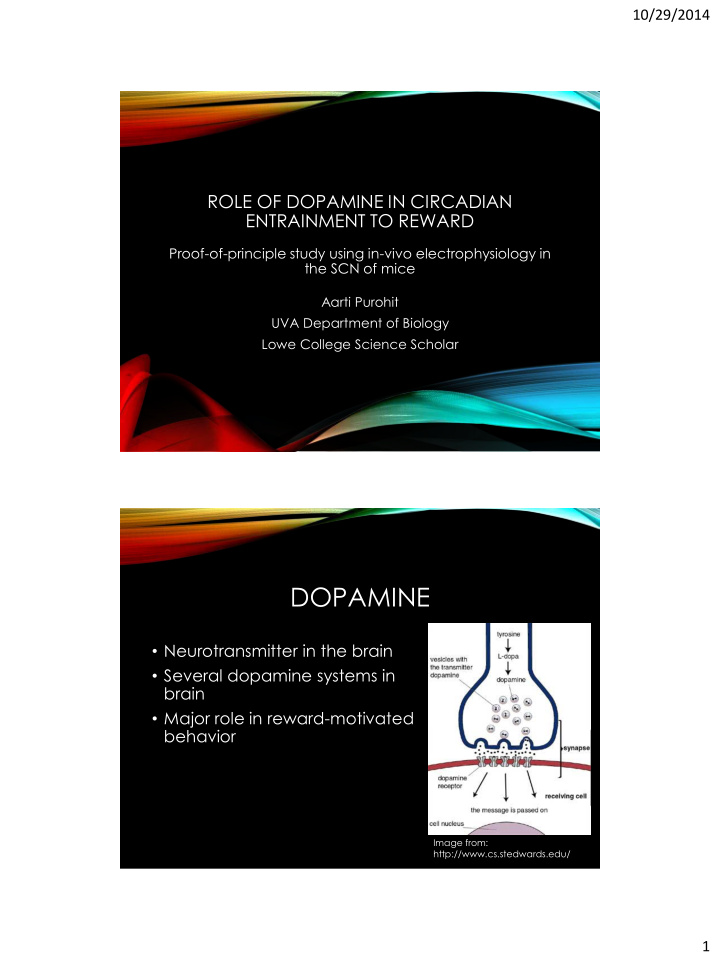



10/29/2014 ROLE OF DOPAMINE IN CIRCADIAN ENTRAINMENT TO REWARD Proof-of-principle study using in-vivo electrophysiology in the SCN of mice Aarti Purohit UVA Department of Biology Lowe College Science Scholar DOPAMINE • Neurotransmitter in the brain • Several dopamine systems in brain • Major role in reward-motivated behavior Image from: http://www.cs.stedwards.edu/ 1
10/29/2014 SUPRACHIASMATIC NUCLEUS (SCN) ‡ Master biological clock & circadian rhythms ‡ Rhythms are endogenous but regulated by environmental cues ‡ Photic vs. non-photic inpu t ‡ Ex: jetlag Images from: Allen Brain Atlas CENTRAL PREMISE ‡ Premise 1: SCN has receptors for dopamine (D1R) ‡ Premise 2: SCN neurons should have light/dark rhythmicity Video from: Welsh DK, Takahashi JS, Kay SA. 2010. Suprachiasmatic nucleus: cell autonomy and network properties. Annu. Rev. Physiol. 72:551 – 77 2
10/29/2014 TECHNIQUE 1: “ DREADDs" ‡ “ D esigner R eceptor E xclusively A ctivated by D esigner D rugs” ‡ Example of “designer drug”: clozapine-N-oxide (CNO) ‡ Cre recombinase used to target DREADD receptors to ONLY neurons that express D1R receptors TECHNIQUE 2: RECORDING IMPLANTS ‡ Records action potentials from single cells ‡ Freely behaving mice ‡ Long-term recordings Image from: http://neuralynx.com Image from: Anikeeva, P. et al . Optetrode: a multichannel readout for optogenetic control in freely moving mice. Nature Neurosci. 15 , 163 – 170 (2012). 3
10/29/2014 EXPERIMENTAL DESIGN ‡ Step 1: surgically implant 4 mice with electrodes targeted at the SCN ‡ Step 2: entrain mice to 12 hr light: 12 hr dark cycle ‡ Step 3: Activate dopamine system and monitor SCN activity ‡ day & night ‡ before & after injecting CNO: 30 min wait time RESULTS ‡ 4 mice injected; 1 headstage had wiring issues ‡ Several units had day/night rhythmicity as well as CNO responsiveness ‡ Interesting action potential shapes recorded 4
10/29/2014 Mouse 0353 Mouse 0298 Mouse 0351 DATA ANALYSIS From Matlab: computational software 5
10/29/2014 EXAMPLE: CELL #11 June 9 June 9 June 10 June 10 Baseline Day CNO Day Baseline Day Baseline Night Firing Rate: Firing Rate: Firing Rate: Firing Rate: 5.94 Hz 10.39 Hz 6.98 Hz 3.34 Hz EXAMPLE: CELL #28 June 16 June 16 June 17 June 17 Baseline Day Baseline Night Baseline Day CNO Day Firing Rate: Firing Rate: Firing Rate: Firing Rate: 0.49 Hz 0.62 Hz 0.43 Hz 0.19 Hz 6
10/29/2014 SIGNIFICANCE ‡ Interesting action potential shape of SCN neurons ‡ Very fast recovery period? ‡ Proof of principle study successful: neuronal activity can be controlled ‡ Next steps: ‡ repeat experiment with more mice and proper targeting ‡ Induce dopamine production in brain (ex. leptin/ghrelin) and monitor SCN activity 14 ACKNOWLEDGEMENTS ‡ Mentor: Professor Ali Guler ‡ Many thanks go to the generous donors of the College Science Scholars program who make these summer research awards possible: Charles Henry Leach, II Foundation; Wendy R. Van Besien and Stephen M. Van Besien; Lois A. Fitton & W. Christopher Draper, Jr.; Sharon B. Parente & John W. Risner; The Jefferson Trust; J. Randolph and Rossie Carter Hutcheson; Entigence Corporation; Robert Atkinson ‡ Special thanks to Mary Baroody Lowe and Jeffrey A. Lowe; The UVa Parents Fund and Committee ‡ The College Science Scholars Program ‡ Ryan Grippo & Aundrea Rainwater 7
Recommend
More recommend